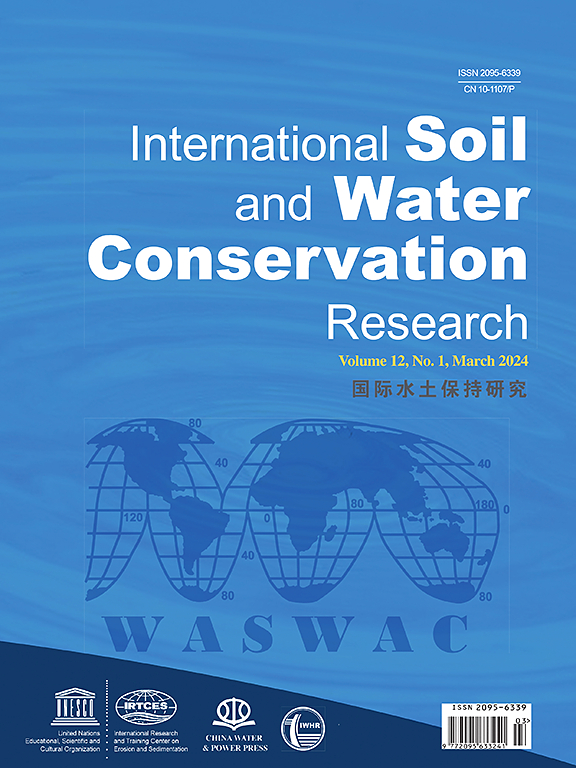使用Landsat 8进行土壤类型分类:美国农业部与以色列当地系统的比较
IF 7.3
1区 农林科学
Q1 ENVIRONMENTAL SCIENCES
International Soil and Water Conservation Research
Pub Date : 2025-03-12
DOI:10.1016/j.iswcr.2025.03.001
引用次数: 0
摘要
数字土壤制图(DSM)是了解土壤与环境之间复杂关系的重要工具。在这项研究中,我们将Ravikovitch于1969年创建的以色列土壤地图数字化(基于当地分类系统),并使用Landsat 8光谱数据通过机器学习预测以色列的土壤类别。我们也做了一个类似的分析,使用全球美国农业部土壤订单层。这项工作是开创性的,这是第一次尝试将拉维科维奇所做的巨大而重要的工作转移到数字层面,通过将这张地图与Landsat 8的卫星观测相结合。我们的研究表明,使用Landsat 8数据结合美国农业部土壤订单数据和机器学习技术的基于光谱的预测可以非常准确地预测以色列(精度= 0.84)和塞浦路斯(精度= 0.88)的美国农业部土壤订单。我们还测试了以色列美国农业部土壤订单模型到塞浦路斯的可转移性,塞浦路斯是一个具有类似土壤分类的邻近国家,然而,在这一阶段获得的准确性很差(准确性= 0.13)。拉维科维奇数字地图上的预测是中等的(精度= 0.54),因为需要太多的类别来预测(24个类别)。我们的研究强调了数字化和更新现有土壤图的重要性,并展示了将机器学习与卫星光谱数据结合起来进行准确土壤分类的潜力。本文章由计算机程序翻译,如有差异,请以英文原文为准。

Soil type classification using Landsat 8: A comparison between the USDA and a local system in Israel
Digital Soil Mapping (DSM) is an essential tool for understanding the complex relationship between soil and the environment. In this study, we digitized the soil map of Israel created by Ravikovitch in 1969 (that was based on a local classification system) and used Landsat 8 spectral data to predict soil classes across Israel using machine learning. We also made a similar analysis using a global USDA soil orders layer. This work is pioneering, and this is the first attempt to transfer the enormous and important work done by Ravikovitch to the digital level by combining this map with satellite observations of Landsat 8. Our study showed that the spectral-based predictions using Landsat 8 data in combination with the USDA soil orders data and machine learning techniques resulted in very accurate predictions of USDA soil orders in Israel (accuracy = 0.84) and in Cyprus (accuracy = 0.88). We also tested the transferability of the Israeli USDA soil orders model to Cyprus, a nearby country with a similar soil taxonomy, however, poor accuracies were obtained at this stage (accuracy = 0.13). The predictions on the digital map of Ravikovitch were intermediate (accuracy = 0.54) because so many classes were required to predict (24 classes). Our study highlights the importance of digitizing and updating existing soil maps, and demonstrates the potential of combining machine learning with satellite spectral data for accurate soil classification.
求助全文
通过发布文献求助,成功后即可免费获取论文全文。
去求助
来源期刊

International Soil and Water Conservation Research
Agricultural and Biological Sciences-Agronomy and Crop Science
CiteScore
12.00
自引率
3.10%
发文量
171
审稿时长
49 days
期刊介绍:
The International Soil and Water Conservation Research (ISWCR), the official journal of World Association of Soil and Water Conservation (WASWAC) http://www.waswac.org, is a multidisciplinary journal of soil and water conservation research, practice, policy, and perspectives. It aims to disseminate new knowledge and promote the practice of soil and water conservation.
The scope of International Soil and Water Conservation Research includes research, strategies, and technologies for prediction, prevention, and protection of soil and water resources. It deals with identification, characterization, and modeling; dynamic monitoring and evaluation; assessment and management of conservation practice and creation and implementation of quality standards.
Examples of appropriate topical areas include (but are not limited to):
• Conservation models, tools, and technologies
• Conservation agricultural
• Soil health resources, indicators, assessment, and management
• Land degradation
• Sustainable development
• Soil erosion and its control
• Soil erosion processes
• Water resources assessment and management
• Watershed management
• Soil erosion models
• Literature review on topics related soil and water conservation research
 求助内容:
求助内容: 应助结果提醒方式:
应助结果提醒方式:


